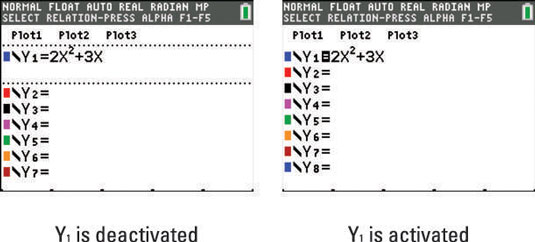Using [–] instead of [(-)] to indicate that a number is negative.
If you press [–] instead of [(-)] at the beginning of an entry, the calculator assumes you want to subtract what comes after the minus sign from the previous answer. If you use [–] instead of [(-)] in the interior of an expression to denote a negative number, the calculator responds with the ERROR: SYNTAX error message.
Indicating the order of operations incorrectly by using parentheses
When evaluating expressions, the order of operations is crucial. To the calculator, for example, –32 equals –9. This may come as quite a surprise to someone expecting to square –3, where (–3)2 equals 9. The calculator first performs the operation in parentheses, then it squares the number, and if there is a negative outside the parentheses, it first performs the squaring and then the operation of negating a number.
Unless you’re careful, this won’t provide the answer you’re looking for. To guard against this error, you may want to review the detailed list of the order in which the calculator performs operations.
Improperly entering the argument for menu functions

If an argument is improperly entered, a menu function won’t work. A prime example is the fMin function housed in the Math MATH menu. Do you remember what to place after this function so that you can use it? If you don’t, you get the ERROR: ARGUMENT error message.
To avoid this error, you can use the Catalog Help feature to see the syntax of the function you would like to use. Press [MATH] and use the down-arrow key to move your cursor to the fMin function as shown in the first screen. Press [+] to access the Catalog Help feature as illustrated in the second screen.
Accidentally deleting a list

If your cursor is in the column heading and you press [DEL], the list disappears from view. List L2 isn’t displayed in the first screen. Don’t worry! You can recover the list by using the SetUpEditor command. Press [STAT][5][ENTER], as shown in the second screen. List L2 is now restored in the List editor. Press [STAT][ENTER] to see the lists, as shown in the third screen.
Entering an angle in degrees in Radian mode
To change the mode, press [MODE], move your cursor to DEGREE and press [ENTER].
Alternatively, you can enter an angle in degrees when you are in Radian mode, but you have to let the calculator know that you’re overriding the Angle mode by placing a degree symbol after your entry. To insert a degree symbol, press [2nd][APPS][ENTER].
Graphing trigonometric functions in Degree mode
This, too, is a mistake unless you do it just right: In the Window editor, you have to set the limits for the x-axis as –360 is less than or equal to x, which is less than or equal to 360.
Pressing [ZOOM][7] or [ZOOM][0] to have the calculator graph the function using the ZTrig or ZoomFit command produces similar results. But this works when you’re graphing pure trig functions such as y = sin x. If you’re graphing something like y = sin x + x, life is a lot easier if you graph it in Radian mode.
Graphing functions when stat plots are active

If you get the ERROR: DIMENSION MISMATCH error message when you graph a function, this is most likely caused by a stat plot that the calculator is trying to graph along with your function. You can turn off the stat plot on the Y= editor screen.
Press [Y=], and see if any of the stat plots are highlighted at the top of the Y= editor screen. Stat Plot1 and Stat Plot3 are highlighted in the first screen. Move your cursor over the highlighted stat plots and press [ENTER] to turn off the stat plots, as illustrated in the second screen.
Inadequately setting the display contrast
If your screen is too light or too dark to read the calculations, you can fix it easily. To adjust the contrast settings to your liking, repeatedly press [2nd] and the up-arrow key to darken the screen or press [2nd] and the down-arrow key to lighten the screen.
Setting the window inappropriately for graphing
If you get the ERROR: WINDOW RANGE error message when graphing functions, this is most likely caused by setting Xmin greater than or equal to Xmax or by setting Ymin greater than or equal to Ymax in the Window editor.
Accidentally deactivating a function

This can be one of the most frustrating mistakes you can make. You have to be paying attention to notice that a function has been deactivated. See the first screen. Notice the equal sign next to Y1 isn’t highlighted. This means the function has been deactivated.
To activate a function that has been deactivated, move your cursor to the equal sign in the Y= editor and press [ENTER].






